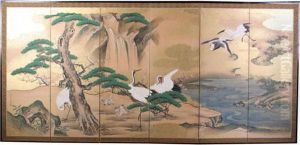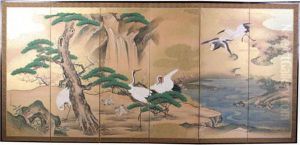Hoin Kosen Tsunenobu Paintings
Hoin Kosen Tsunenobu was a Japanese artist who lived during the Edo period, a time characterized by economic growth, strict social orders, isolationist foreign policies, and a flourishing art and culture scene. Born in 1631, Tsunenobu was part of the Kano school, one of the most famous and influential schools of Japanese painting. The Kano school served the shogunate and feudal lords, creating works that adorned castles, temples, and villas, epitomizing the aesthetic tastes and ideals of the warrior class and the ruling elite.
Tsunenobu was known for his masterful use of ink and color on screens and sliding panels, his work often depicting themes from nature, history, and mythology, aligned with the Kano school's style that combined realism with stylized compositions. He became particularly renowned for his skillful representation of birds and flowers, landscapes, and figures, imbuing his subjects with a sense of vitality and dynamism that was highly appreciated by his contemporaries.
Throughout his career, Tsunenobu served under the patronage of the Tokugawa shogunate, contributing to the decoration of many significant buildings and participating in major art projects of his time. His legacy is significant in the history of Japanese art, not only for his contributions to the Kano school's body of work but also for his role in mentoring future generations of artists, thus ensuring the continuation of the school's traditions and styles. Tsunenobu's works are preserved in several important collections in Japan and around the world, testament to his enduring influence on Japanese art. He passed away in 1697, leaving behind a rich legacy that continues to be studied and admired.

